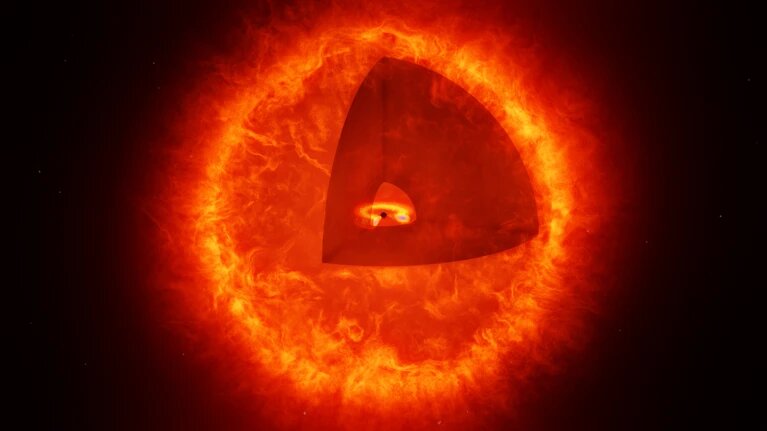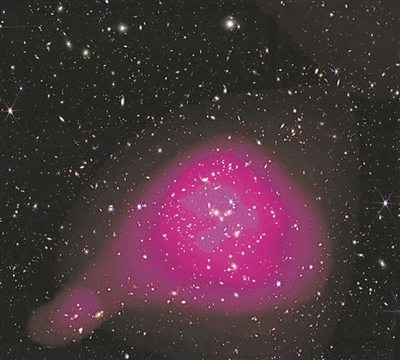
Looking back at images from the early universe, the James Webb Space Telescope (JWST) has revealed a truly bizarre sight to astronomers: hundreds of tiny red dots inexplicably dotting the ancient universe. Over the past few months, a growing consensus has emerged that these specks, dubbed "rubies," represent an entirely new type of celestial object.

An artist's conception of a black hole star, the theory many astronomers favor to explain the Red Spot. Image credit: MPIA/HdA
These blobs, named for their compact size and emission of long-wavelength "red" light in JWST images, initially puzzled astronomers. They appeared too dense to be galaxies, yet emitted a spectrum of light inconsistent with that of a black hole. Researchers quickly dubbed these blobs, first detected by JWST in 2022, "cosmic disruptors" because they contradicted standard ideas about the characteristics of the early universe.
Many scientists believe that little red dots (LRDs) are a hybrid between a black hole and a star: an active black hole is surrounded by a cocoon of hot, dense gas—much like a star's atmosphere—that glows as the black hole heats it up. In contrast, more traditional black holes don't glow in the same way.
Even if astronomers settle on a leading theory about the nature of these mysterious spots, they still have many questions: Do LRDs exist only in the oldest regions of the universe, or do they also exist in more recent regions? How do they evolve over time? And how do they form in the first place?
Three years after JWST first observed LRDs, about 200 research manuscripts have been posted on the arXiv preprint server, some of which have not yet been peer-reviewed. Nature has compiled a list of highlights from the past three months that are revealing this tantalizing new class of objects.
The most crucial LRD, an object called "The Cliff," provides the strongest evidence yet for the black hole-star model. The object gets its name from a sharp break in its emission spectrum: On a graph showing the wavelengths of light emitted by the object at a given moment, ultraviolet radiation outside the visible spectrum drops to almost zero, but then suddenly surges at slightly lower-energy wavelengths.
"This kind of abrupt transition isn't something you'd expect from a normal galaxy," says Anna de Graaff, an astronomer at the Max Planck Institute for Astronomy in Heidelberg, Germany, and co-author of a paper published last month in Astronomy & Astrophysics. "And black holes in the nearby universe don't look like that either. So this is the first object that rules out a whole host of models." For this reason, the authors call the cliff an "extraordinary ruby."
Analysis of the peaks in optical emission suggests that the object must be extremely energetic, like a black hole, but must also be surrounded by a warm, dense gas, similar to the atmosphere of a star. The researchers' interpretation of this object matches a model described earlier this year of a black hole surrounded by gas, and thus, a black hole star is born.
Besides determining what LRDs are, astronomers are also curious about how they evolve. Some believe these rubies could become the centers of galaxies. Jan-Torge Schindler, an astronomer at the University of Hamburg in Germany, says the LRD featured in their paper published last month in Nature Astronomy is surrounded by eight nearby galaxies and embedded in a particularly massive clump of dark matter. Dark matter, the invisible substance that binds galaxies together, is a type of halos. Such massive dark matter halos often contain quasars, the extremely bright nuclei at the centers of some galaxies.
Two other studies have further explored LRDs through some extreme examples: some of the closest and most distant observations. In a preprint published in July, astronomers described three LRDs about 1 billion light-years from Earth. This is closer to our region of the universe than most LRDs, which are about 12 billion to 13 billion light-years away. Objects relatively close to Earth are not as observable as those far away. Therefore, this discovery suggests that these spots are not only "inhabitants" of the early state of the universe, but may even have appeared in a more mature universe.
Meanwhile, astronomer Anthony Taylor of the University of Texas at Austin and his colleagues have found the perfect complement to those nearby blobs. The LRD they described in a paper published in August in The Astrophysical Journal Letters is particularly distant, meaning that when astronomers study it, they are actually looking back to a period just 500 million years after the Big Bang.
Taylor hopes that by peering into the ancient universe, he can gain a deeper understanding of how these systems formed. With future observations, he looks forward to seeing how astronomers continue to piece together this cosmic puzzle.
